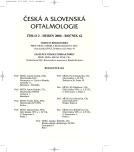-
Medical journals
- Career
The Ultrasound Findings in Posttraumatic Endophthalmitis
Authors: K. Marešová; J. Kalitová; J. Šimičák; J. Řehák
Authors‘ workplace: Oční klinika LF UP a FN, Olomouc přednosta doc. MUDr. Jiří Řehák, CSc.
Published in: Čes. a slov. Oftal., 62, 2006, No. 2, p. 125-132
Overview
The aim of this study was to evaluate the ultrasound findings in eyes with endophthalmitis following penetrating injury and to establish unfavorable predictive signs of this serious disease. In a retrospective study we evaluated findings in 7 eyes of 7 patients followed up because of posttraumatic endophthalmitis at the Department of Ophthalmology, School of Medicine, in Olomouc, Czech Republic, EU, during the period September 1999 – December 2004. The mean age of the patients was 37.3 years (range 22-49 years). The mean duration of the period between the injury and the formation of the endophthalmitis was 8.4 days (range 1 – 21 days). The visual acuity at the time of admittance was very low; it ranged between light perception and 1/60 (0,016 or 20/1200). All patients underwent diagnostic-therapeutic pars plana vitrectomy with vitreous samples taken for microbiological examination and intravitreal antibiotic application. The final visual acuity (VA) ranged from 1/60 (0,016 or 20/1200) to 6/12 (0.5 or 20/40), so it was very variable and that gave us the possibility to follow the connection between the final VA and seriousness of the penetrating injury, and also with the interval between the emergence of the endophthalmitis and beginning of its treatment. During the ultrasound examination, the presence of membranes in the vitreous body, posterior vitreous detachment, thickening of the choroid, detachment of the choroid and detachment of the retina were of concern to us. Membranes were present in the vitreous in 5 eyes. Without membranes detected by the ultrasound, there were 2 eyes; in both of them the final VA was better than 6/36 (0,1667 or 20/120). The posterior vitreous detachment was detected in 3 eyes, and not detected in four eyes.We didn’t find any connection between the final VA and posterior vitreous detachment. The thickening of the choroid was present at the ultrasound examination in all seven eyes. The detachment of the choroid was not found in any eye. The retina was detached in two eyes. In three eyes only, the final central VA was better than 6/36 (0.1667 or 20/120). In two of them, the intraocular foreign body was found and in both the bacteria Staphylococcus epidermidis was detected. In the third eye, the soil bacteria Enterococcus and Klebsiela were cultivated. The ultrasound findings in these three eyes are identical only in the term of thickening of the choroid, similar to other eyes. In two of them no membranes were detected by ultrasound and no posterior vitreous detachment was found. The ultrasound examination in eyes with endophthalmitis after penetrating injury is specific in particular because of the mechanism of the injury. In contrast to the cases of the postoperative endophthalmitis, no prognostic unfavorable sings in the ultrasound examination can be strictly identified.
Key words:
ultrasound, endophthalmitis
Labels
Ophthalmology
Article was published inCzech and Slovak Ophthalmology

2006 Issue 2-
All articles in this issue
- Bilateral Retinal Vasculitis with Arterial Aneurysms
- Iris Racemose Vascular Anomalies
- The Orbital Implant after Exenteration of the Orbit with the Preservation of the Eyelids and the Conjunctival Sac
- Optical Coherence Tomography in Pars Plana Vitrectomy for Idiopathic Macular Hole
- Computer Modeling Correlation between the Entering Wound and the Final Position of the Metallic Intraocular Foreign Body
- Contribution to Differential Diagnosis of Intraocular Tumors – Case Report
- The Ultrasound Findings in Posttraumatic Endophthalmitis
- The Influence of IOL Implantation on Visual Acuity, Contrast Sensitivity and Colour Vision 2 and 4 Months after Cataract Surgery
- Vernal Keratoconjunctivitis and Possibilities its Treatment
- Czech and Slovak Ophthalmology
- Journal archive
- Current issue
- Online only
- About the journal
Most read in this issue- Vernal Keratoconjunctivitis and Possibilities its Treatment
- The Orbital Implant after Exenteration of the Orbit with the Preservation of the Eyelids and the Conjunctival Sac
- The Influence of IOL Implantation on Visual Acuity, Contrast Sensitivity and Colour Vision 2 and 4 Months after Cataract Surgery
- Bilateral Retinal Vasculitis with Arterial Aneurysms
Login#ADS_BOTTOM_SCRIPTS#Forgotten passwordEnter the email address that you registered with. We will send you instructions on how to set a new password.
- Career

